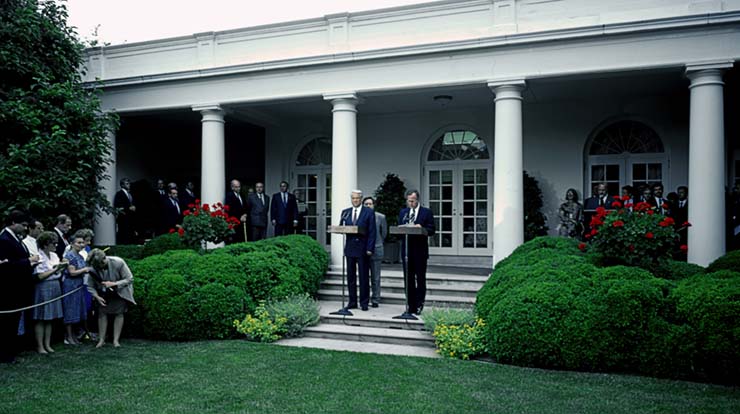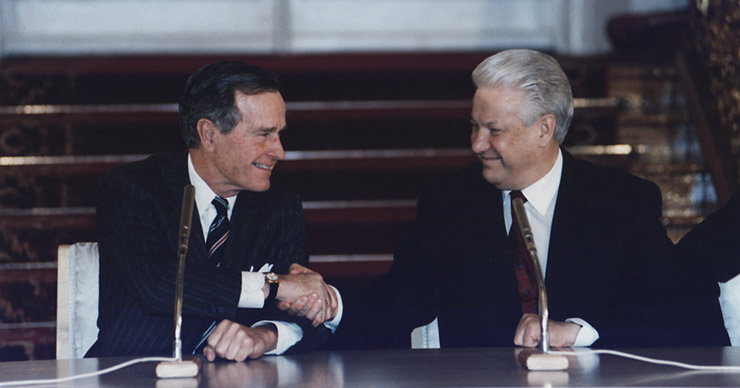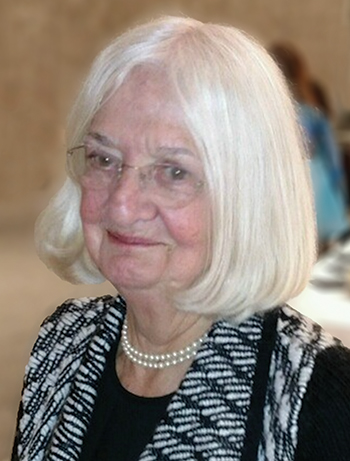


December 6, 2023
IMAGE: Russian President Boris Yeltsin and US President George H. W. Bush at the White House Rose Garden announcing an agreement to sharply reduce both countries’ strategic nuclear arsenals. The author is standing in the colonnade, behind President Bush, on the right side of the photo. Washington, DC, June 16, 1992. (Photo by Mark Reinstein/Corbis via Getty Images)
I learned about the Presidential Nuclear Initiatives (PNIs) along with the rest of the world when the US president announced them on prime-time television in 1991. I was assistant director for strategic and nuclear affairs at the Arms Control and Disarmament Agency (ACDA). When I asked the agency director about reduction rumors, he told me not to ask.
From his desk in the Oval Office, President George H. W. Bush announced “a series of sweeping initiatives affecting every aspect of our nuclear forces on land, on ships, and on aircraft.” It was a mere 22 days after he had directed the Defense Department to propose unilateral nuclear reductions, especially in short-range forces.[1] Only a small number of Pentagon officials were involved in that work, and virtually no one from other agencies.
The process and substance of the PNIs of 1991 and 1992 are without parallel in the history of nuclear risk reduction. While the PNIs are best remembered for their reductions in US short-range nuclear forces, they also led to the START II Treaty and to the first US-Soviet discussions of nuclear warhead security, which developed a few years later into important US-Russian nuclear security cooperation under the Cooperative Threat Reduction (CTR) program.[2]
By 1991, I had been working on nuclear arms control issues, at the Office of the Secretary of Defense (OSD) and then ACDA, for just under 10 years. We were proud of our accomplishments with the INF and START I Treaties, but each of those took many years to negotiate with the Soviet Union. Interagency negotiations within the US government were also sometimes long and difficult. My colleagues and I could not believe that the United States could agree in such a short time on very far-reaching nuclear reductions.
Our astonishment only deepened just over a week later, when an interagency delegation—in which I participated—arrived in Moscow. Our aim was to explain the PNI to our counterparts and urge them to adopt comparable steps. The US PNI measures were completely unilateral, but we hoped the Soviet Union would reciprocate. I cannot speak for my colleagues, but I for one did not expect any positive results from this visit.
Ours was the first official US government delegation to stay at the first US hotel in Moscow. The Radisson Slavyanskaya, next to the Kyiv Railway Station, was not quite up to Western standards. The rooms were spartan and small, with cheap plywood furniture. I and some of my colleagues were still checking in when our head of delegation returned to the lobby to complain strongly about the quality of his room. Still, the Radisson was a definite improvement over the Soviet hotels with their “key ladies.” And within a few years, we had many more American hotels from which to choose.
A few minutes after his complaints about the Radisson, our head of delegation had more important things to think about. He was invited urgently to the Foreign Ministry, where he was shown an address that Soviet President Mikhail Gorbachev would give on television that evening. Even the most optimistic of our delegation were astonished when he returned with the text. Just eight days after President Bush’s speech, and without a word of negotiation, Gorbachev announced far-reaching reciprocal Soviet steps. Our delegation joked that we were such superb negotiators that our mere presence in the country was enough to win an outcome beyond our wildest hopes. In truth, and much more importantly, however, we were beginning to realize that we were entering a new era of US-Soviet/Russian relations unlike anything we had ever experienced.
Seismic global, and accompanying personal, change kept accelerating. Not quite three months after President Bush’s first PNI speech, the Soviet Union ceased to exist, leaving 15 newly independent states, including four (Russia, Ukraine, Belarus, and Kazakhstan) with nuclear warheads and delivery systems on their territory. Personally, just a few weeks before the Soviet Union collapsed, I moved from ACDA to the White House National Security Council (NSC) staff as the de facto deputy head of the Directorate for Defense Policy and Arms Control. Thus began the most exciting, rewarding, and exhausting year of my professional life.
Our work was aided immeasurably by the key interagency arms control group created a few years before by the then-NSC staff senior director for defense policy and arms control, to overcome bureaucratic obstacles for arms control and nonproliferation decision-making. The “Ungroup,” so named because it had not been officially established, brought together officials from all the concerned agencies who were senior enough to be able to speak for their agencies and junior enough to be expert in arms control and nonproliferation. The group members left their individual agency interests at the door and instead worked to pursue the national interest. My immediate boss normally chaired the Ungroup, and I chaired in his absence.
On December 12, 1991, President Bush signed into law the Soviet Nuclear Threat Reduction Act, which created the CTR program, initially proposed by Senators Sam Nunn of Georgia and Richard Lugar of Indiana. I chaired the interagency group charged with setting up the program. The task was not easy. No one within the US government had any experience with such broad cooperation with Russia, nor any at all with the new states of Ukraine, Belarus, and Kazakhstan. Moreover, Congress had imposed certification requirements for CTR assistance that seemed impossible to meet. Further, Congress had authorized $400 million to start the program but appropriated nothing for it. At one very productive interagency meeting, it was announced that the Department of Defense would provide the $400 million “out of hide,” or from existing funds, and we found a way to meet the certification requirements. Shortly thereafter, in mid-January 1992, I was the NSC member of a small delegation to Moscow, Kyiv, Minsk, and Almaty to discuss possible CTR projects. Little did we realize what the program would become over the next 30-plus years.
President Bush announced a second set of PNI measures in his State of the Union speech on January 28, 1992. The next day, Russian President Boris Yeltsin announced new reciprocal Soviet steps and proposals. Gorbachev learned of the first PNI only hours before President Bush’s speech. The short time before his positive response was astonishing, especially given the chaos in Moscow just one month after the August Putsch. President Yeltsin clearly must have had more advance notice of the second US PNI, but still the responsiveness of the Russian government, which had existed for only 35 days, was far beyond what could be expected.
Because of the PNIs, the US nuclear warhead stockpile fell by almost 50 percent between December 1990 and December 1994. In absolute numbers, the United States removed 10,413 nuclear warheads from its arsenal.[3]
For the first year or so, the United States and the Soviet Union/Russia exchanged regular reports on implementation of promised reductions. All appeared to be going well, with both sides reporting substantial and rapid progress in reductions. However, the Russian reports became repetitive, with no stockpile changes noted. After some months, we just gave up, and the exchanges on PNI reductions ceased. That was disappointing to say the least but by itself did not hinder continued progress on nuclear risk reduction. Other arms control and CTR discussions and cooperation continued apace—at least for a while.
Few people realize that the PNIs led directly to the START II Treaty, which would have significantly reduced deployed strategic nuclear warheads and eliminated all US and Russian intercontinental ballistic missiles with multiple independently targetable warheads. President Bush proposed such a treaty in his second PNI address. By the time of the US-Russian summit in Washington in June 1992, the sides had agreed to a Joint Framework for the treaty, an agreement that was finalized just an hour or two before Presidents Bush and Yeltsin were scheduled to announce it in the White House Rose Garden.
My last task before the announcement was to print up the five-by-eight-inch note cards the president liked to use for his speeches. (The NSC staff in those days was quite small, and we all did whatever work was required.) To my horror, the printer jammed, and no one could fix it. I did not react calmly, but I had no choice and delivered to the president my typed sheet of announcement points. I felt terrible but never heard a word of complaint, and I was still allowed to watch the announcement with colleagues right behind the president.

Photo by Mark Reinstein/Corbis via Getty Images
The next months continued to be very busy. There were still issues to negotiate after the June 1992 summit. And the November elections created a very unusual, and very productive, presidential transition. Technically, the transition team of President-elect Bill Clinton had no role in policymaking before the inauguration, but it was clear they would appreciate the outgoing Bush administration completing START II and the Chemical Weapons Convention (CWC), lest those be delayed by the inevitable disruptions of a change in administration. Also, I was clearly instructed to inform the Clinton arms control experts of significant negotiating moves we were planning, to ensure that the new administration would fully support the treaty, which it would have to usher through the Senate.
Washington-based decision-making on START II and CWC was the province of the Ungroup, providing guidance to our negotiators in Geneva. The United States and Russia hoped that Presidents Bush and Yeltsin would sign START II in Sochi, Russia, on January 3, 1993. The venue was changed to Moscow when the White House advance team could not land in Sochi because of a snowstorm.

Photo courtesy of the George H. W. Bush Presidential Library and Museum
Reaching final substantive agreement was more difficult than the logistics. My colleagues and I had very unusual Christmas holidays. On December 24, our Geneva delegation flew home. That afternoon, the two presidents discussed the remaining issues. I managed to catch an 8:00 p.m. flight to join my family, discovering that airports and planes were not crowded at that hour on Christmas Eve. On Saturday the 26th, I caught a 6:00 a.m. flight back to Washington, in time for a 10:00 a.m. Ungroup meeting to wrap everything up. On the morning of Sunday the 27th, the Ungroup gathered at Andrews Air Force Base to see our negotiators off to Geneva. They brought the completed treaty to Moscow on January 2, and it was signed on schedule the next day.
We could celebrate, but not exhale. The CWC was open for signature just 10 days later, on January 13. President Bush submitted the START II Treaty, with an accompanying 75-page, article-by-article analysis, to the Senate on January 15. And we had to complete all the transition materials for the new administration before the 20th.
I remember well my last task in the Bush administration. Under the Presidential Records Act, all my materials had to be boxed up and sent to the National Archives before Bill Clinton’s inauguration at noon on January 20. Late on the night of the 19th, I just emptied the contents of my six, four-drawer safes into the boxes and taped them up. There was no time to remove personal materials that didn’t belong as presidential records. I’ve long felt sorry for the poor archivists who had to figure out what to do with them.
My colleagues and I were exhausted but proud of what we had accomplished. I did not expect to be told, just a few days later, that I could not stay on the NSC staff. Luckily, my return to OSD, my home agency, was a happy and productive one, working as deputy assistant secretary for threat reduction policy on arms control and nonproliferation policy, including CTR. Perhaps the most important lesson I learned from my Bush 41 NSC staff experience was to think in terms of the national—rather than narrow, bureaucratic—interest. Certainly, the highest compliment I ever received from a staff member was when he thanked me for teaching him the same habit of thought.
After spending the Clinton administration in OSD, I returned to the NSC staff and then went to the State Department in the Bush 43 administration. During the 1990s, I concentrated on CTR and continued that great sense of accomplishment. Gradually, in the subsequent years, that all turned for the worse. The chances of START II coming into force were close to nonexistent by late 1997, and Russia finally declared it null and void in 2002. CTR work in Russia continued but faced increasing bureaucratic obstacles until Moscow officially terminated the program in 2013. A year later, Russia invaded Ukraine for the first time, in an egregious violation of the Budapest Memorandum on which we had worked closely together in 1994.
When we began CTR in Russia in 1992, we proposed close cooperation on nuclear material security. But we thought it too sensitive to suggest helping their warhead security, except for some limited efforts to increase safety and security of transport of warheads from Ukraine, Belarus, and Kazakhstan. By 1995, our years of cooperation had helped to expand and deepen trust, and the Russian military asked us for assistance on security of their warheads in storage and internal transport. In doing so, a senior Russian general mentioned to a few of us that “you’re not the enemy, proliferation is.” That world is now well in the past. It was mutually rewarding while it lasted.
The views expressed in this post are those of the author and not necessarily those of the Stanley Center for Peace and Security or any other agency, institution, or partner.
[1] Short-range forces were a category of weapons that had been excluded from the reductions of the recent Intermediate-Range Nuclear Forces (INF) Treaty and the Strategic Arms Reduction Treaties (START).
[2] For details on the process and substance of the PNIs, see Susan J. Koch, The Presidential Nuclear Initiatives of 1991–1992, Center for the Study of Weapons of Mass Destruction, Case Study 5, National Defense University, September 2012.
[3] Only one other US president has presided over a 50-percent reduction in the nuclear stockpile. Few people realize it was President George W. Bush, over an eight-year term with a much smaller initial number.

Before she retired from government service, Susan Koch held senior positions in the White House National Security Council Staff, State Department, Office of the Secretary of Defense, and Arms Control and Disarmament Agency, focusing on arms control and nonproliferation.
The Stories